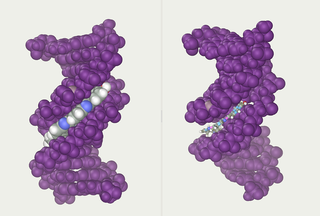In physics, statistical mechanics is a mathematical framework that applies statistical methods and probability theory to large assemblies of microscopic entities. It does not assume or postulate any natural laws, but explains the macroscopic behavior of nature from the behavior of such ensembles.

Molecular mechanics uses classical mechanics to model molecular systems. The Born–Oppenheimer approximation is assumed valid and the potential energy of all systems is calculated as a function of the nuclear coordinates using force fields. Molecular mechanics can be used to study molecule systems ranging in size and complexity from small to large biological systems or material assemblies with many thousands to millions of atoms.
Gaussian is a general purpose computational chemistry software package initially released in 1970 by John Pople and his research group at Carnegie Mellon University as Gaussian 70. It has been continuously updated since then. The name originates from Pople's use of Gaussian orbitals to speed up molecular electronic structure calculations as opposed to using Slater-type orbitals, a choice made to improve performance on the limited computing capacities of then-current computer hardware for Hartree–Fock calculations. The current version of the program is Gaussian 16. Originally available through the Quantum Chemistry Program Exchange, it was later licensed out of Carnegie Mellon University, and since 1987 has been developed and licensed by Gaussian, Inc.

Molecular modelling encompasses all methods, theoretical and computational, used to model or mimic the behaviour of molecules. The methods are used in the fields of computational chemistry, drug design, computational biology and materials science to study molecular systems ranging from small chemical systems to large biological molecules and material assemblies. The simplest calculations can be performed by hand, but inevitably computers are required to perform molecular modelling of any reasonably sized system. The common feature of molecular modelling methods is the atomistic level description of the molecular systems. This may include treating atoms as the smallest individual unit, or explicitly modelling protons and neutrons with its quarks, anti-quarks and gluons and electrons with its photons.

In the context of chemistry, molecular physics and physical chemistry and molecular modelling, a force field is a computational model that is used to describe the forces between atoms within molecules or between molecules as well as in crystals. Force fields are a variety of interatomic potentials. More precisely, the force field refers to the functional form and parameter sets used to calculate the potential energy of a system of the atomistic level. Force fields are usually used in molecular dynamics or Monte Carlo simulations. The parameters for a chosen energy function may be derived from classical laboratory experiment data, calculations in quantum mechanics, or both. Force fields utilize the same concept as force fields in classical physics, with the main difference that the force field parameters in chemistry describe the energy landscape on the atomistic level. From a force field, the acting forces on every particle are derived as a gradient of the potential energy with respect to the particle coordinates.

PQS is a general purpose quantum chemistry program. Its roots go back to the first ab initio gradient program developed in Professor Peter Pulay's group but now it is developed and distributed commercially by Parallel Quantum Solutions. There is a reduction in cost for academic users and a site license. Its strong points are geometry optimization, NMR chemical shift calculations, and large MP2 calculations, and high parallel efficiency on computing clusters. It includes many other capabilities including Density functional theory, the semiempirical methods, MINDO/3, MNDO, AM1 and PM3, Molecular mechanics using the SYBYL 5.0 Force Field, the quantum mechanics/molecular mechanics mixed method using the ONIOM method, natural bond orbital (NBO) analysis and COSMO solvation models. Recently, a highly efficient parallel CCSD(T) code for closed shell systems has been developed. This code includes many other post Hartree–Fock methods: MP2, MP3, MP4, CISD, CEPA, QCISD and so on.
Monte Carlo molecular modelling is the application of Monte Carlo methods to molecular problems. These problems can also be modelled by the molecular dynamics method. The difference is that this approach relies on equilibrium statistical mechanics rather than molecular dynamics. Instead of trying to reproduce the dynamics of a system, it generates states according to appropriate Boltzmann distribution. Thus, it is the application of the Metropolis Monte Carlo simulation to molecular systems. It is therefore also a particular subset of the more general Monte Carlo method in statistical physics.

Spartan is a molecular modelling and computational chemistry application from Wavefunction. It contains code for molecular mechanics, semi-empirical methods, ab initio models, density functional models, post-Hartree–Fock models, and thermochemical recipes including G3(MP2) and T1. Quantum chemistry calculations in Spartan are powered by Q-Chem.

William L. Jorgensen is a Sterling Professor of Chemistry at Yale University. He is considered a pioneer in the field of computational chemistry. Some of his contributions include the TIP3P, TIP4P, and TIP5P water models, the OPLS force field, and his work on free-energy perturbation theory for modeling reactions in solution, protein-ligand binding, and drug design; he has over 400 publications in the field. Jorgensen has been the Editor of the ACS Journal of Chemical Theory and Computation since its founding in 2005.
Free-energy perturbation (FEP) is a method based on statistical mechanics that is used in computational chemistry for computing free-energy differences from molecular dynamics or Metropolis Monte Carlo simulations.
This is a list of computer programs that are predominantly used for molecular mechanics calculations.
Molecular design software is notable software for molecular modeling, that provides special support for developing molecular models de novo.

Molecular modeling on GPU is the technique of using a graphics processing unit (GPU) for molecular simulations.

CP2K is a freely available (GPL) quantum chemistry and solid state physics program package, written in Fortran 2008, to perform atomistic simulations of solid state, liquid, molecular, periodic, material, crystal, and biological systems. It provides a general framework for different methods: density functional theory (DFT) using a mixed Gaussian and plane waves approach (GPW) via LDA, GGA, MP2, or RPA levels of theory, classical pair and many-body potentials, semi-empirical and tight-binding Hamiltonians, as well as Quantum Mechanics/Molecular Mechanics (QM/MM) hybrid schemes relying on the Gaussian Expansion of the Electrostatic Potential (GEEP). The Gaussian and Augmented Plane Waves method (GAPW) as an extension of the GPW method allows for all-electron calculations. CP2K can do simulations of molecular dynamics, metadynamics, Monte Carlo, Ehrenfest dynamics, vibrational analysis, core level spectroscopy, energy minimization, and transition state optimization using NEB or dimer method.

Abalone is a general purpose molecular dynamics and molecular graphics program for simulations of bio-molecules in a periodic boundary conditions in explicit or in implicit water models. Mainly designed to simulate the protein folding and DNA-ligand complexes in AMBER force field.

Ascalaph Designer is a computer program for general purpose molecular modelling for molecular design and simulations. It provides a graphical environment for the common programs of quantum and classical molecular modelling ORCA, NWChem, Firefly, CP2K and MDynaMix . The molecular mechanics calculations cover model building, energy optimizations and molecular dynamics. Firefly covers a wide range of quantum chemistry methods. Ascalaph Designer is free and open-source software, released under the GNU General Public License, version 2 (GPLv2).
MacroModel is a computer program for molecular modelling of organic compounds and biopolymers. It features various chemistry force fields, plus energy minimizing algorithms, to predict geometry and relative conformational energies of molecules. MacroModel is maintained by Schrödinger, LLC.
Massively Parallel Monte Carlo (MPMC) is a Monte Carlo method package primarily designed to simulate liquids, molecular interfaces, and functionalized nanoscale materials. It was developed originally by Jon Belof and is now maintained by a group of researchers in the Department of Chemistry and SMMARTT Materials Research Center at the University of South Florida. MPMC has been applied to the scientific research challenges of nanomaterials for clean energy, carbon sequestration, and molecular detection. Developed to run efficiently on the most powerful supercomputing platforms, MPMC can scale to extremely large numbers of CPUs or GPUs. Since 2012, MPMC has been released as an open-source software project under the GNU General Public License (GPL) version 3, and the repository is hosted on GitHub.
Q is a computer software package for molecular dynamics (MD) simulation. Unlike other MD codes, it has specialized since its conception on three specific types of free energy calculations. These calculations are based on the methods: empirical valence bond (EVB), free energy perturbation (FEP), and linear interaction energy (LIE), as well as, more recently, also path integral calculations using the bisection quantum classical path (BQCP) approach.







